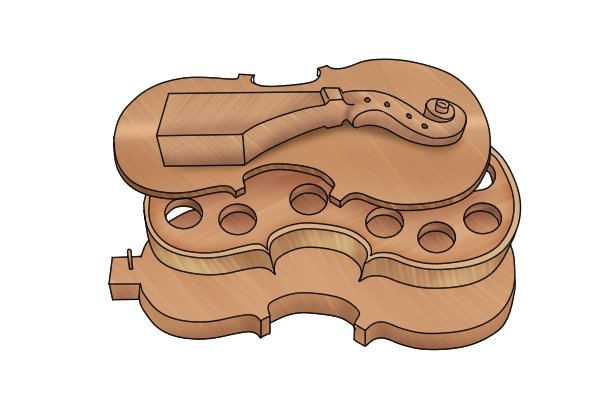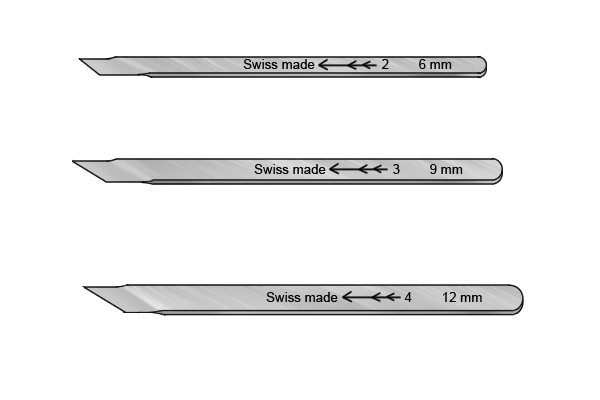
Are there any alternatives to Marking knives?
| Marking knives are not the only wood marking tools that are used to mark out workpieces. Awl, carpentry knives, and precision knives are a few examples that are similar to marking knives. They are used for the same tasks, and even more. Read on to learn about alternatives to knife markings. | |
awl | |
 | An awl is a marking tool used in woodworking. It consists of a long, sharp spike attached to a handle. A scratch awl is similar to a marking knife in that it is used to mark the lines that a saw or chisel will follow. An awl can also be used to make holes in workpieces to provide pilot holes for drill bits or items such as screws and nails. |
 | An awl-scraper is more suitable for working along the grain, since the thorn makes a groove in the wood, and does not cut it, as a marking knife does. If you use a scriber knife to cut along the grain, the sharp blade can follow the grain in the wood, throwing the line off course. |
 | The long spike of the scraper awl makes it possible to use it in hard-to-reach places. For example, in dovetail marking, the pointed tip of the awl allows users to easily reach and mark the grooves. The marked lines won't be as fine and precise as those made with a marking knife, but an awl is still a useful dovetail marking tool. |
 | If you had to choose between a marking knife and an awl, it can be difficult as there isn't much of a difference. A scratch awl would be the perfect tool for those who work along the grain. Marking knives are ideal for working across the grain and provide finer and more precise marks. |
Precision knives (craft knives) | |
 | Precision knives are knives with a small blade and a handle-like body. They are used in craft work, usually for cutting paper, plastic and wood. They have single-sided, replaceable blades with flat backs. |
 | The interchangeable blades available for precision knives make them very versatile: they can be used in a wide variety of applications. These blades can be used in tight spaces for thinner, more precise cuts, and they allow you to position your knife in multiple ways. |
 | The overall length of a precision knife makes it difficult to control or maneuver when the blade scratches deep or narrow places. The more the blade is inside the workpiece, the less the handle has to be held by the user. |
 | A scriber knife can have a single or double bevel blade so you can cut in multiple directions. A precision knife, on the other hand, only comes with a beveled side of the blade, meaning that to mark out different areas, you have to move across the workpiece or rotate the workpiece to accommodate the blade. |
 | Marking along a straight edge or narrow seams are tasks best handled by a precision knife. However, it is not suitable for marking seams with deep areas that require marking. Generally, a precision knife would be a suitable alternative, but marking knives are much more suitable for all types of wood marking. |
 | Marking knives are stronger, have a longer overall length, and provide the same exact markings as precision knives. |
Woodworking knives | |
 | Woodworking knives have a double beveled blade and handle forged as one piece. The two bevels are on the opposite side of the blade, not on the same side but on opposite edges. |
 | They are used in the manufacturing process of fine furniture and instruments, including violins and lutes. The design of woodworking knives makes them ideal for straight edge marking, loop tracking, seam marking and other marking applications. |
 | The different blade widths available for woodworking knives mean they can be used in difficult areas such as dovetail markings in tight spaces. The blades are beveled on both sides, so the knife can be used to cut in any direction without having to move the workpiece. |
| Woodworking knives do not have a curly handle but a shank that gives the user control but can be uncomfortable. Using this type of knife for long periods of time can cause fatigue in your dominant hand. The design does not allow comfortable placement of fingers and thumbs, like a curly handle with notches. | |
| Woodworking knives are very similar to marking knives and are a great alternative. However, they do not provide the convenience of a marking knife. Marking knives are capable of performing all the same tasks as carpentry knives, but offer the user comfort and control through a range of different handles. | |
| Woodworking knives have bevels on both sides of the blade, unlike a marking knife which has a flat back blade. The flat back of the scriber knife means it can be positioned perfectly flat at the edge for a more precise line. In general, a marking knife would be a better option because it is more accurate and handy. | |
carpenter's knife | |
| A carpenter's knife is a long, curved blade that folds into a handle to reduce storage space and prevent possible injury. It can be used to clean electrical wires and mark wood, or as a wedge to split small logs. | |
| The blade has a bevel on opposite sides of the blade, unlike double bevel marking knives which have bevels on the same side of the blade but on opposite edges. | |
| A carpenter's knife is suitable for marking along a straight edge, but not for marking in narrow places. The blade is long and wide, making it difficult to maneuver in tight spaces, such as dovetail markings. | |
| A carpenter's knife requires a full palm grip when marking out because the shape of the handle is most comfortable when held this way. The design of the knife also allows you to place your index finger over the blade to apply pressure when marking. The marking knife can be held like a pencil or like a carpenter's knife, giving you options when you need more control. | |
| The problem with carpenter's knives is that the blade is beveled on both sides, so it's thicker than a scriber's blade. A thicker blade will cut wider when marking wood, providing a line that is not as fine and precise as a marking knife. | |
| The marking knives are available in a variety of blade angles and thicknesses, as well as a choice of single or double bevel blades. This makes them versatile – they can be used to draw straight edges, mark corners, and mark large or narrow seams. A carpenter's knife is not ideal for detailed markings such as dovetails due to its long, thick blade. | |
Utility knives | |
| Utility knives are very versatile tools that can be used for a range of tasks in the workplace. They are used for cutting wood, cardboard, plastic and various materials. These types of knives are available with blades that can be pulled out or fixed, or that can be broken off. | |
| Different types of blades are suitable for different tasks. For example, a fixed blade is best for marking along straight edges. The short blade and the thickness of the handle did not allow the knife to penetrate hard-to-reach places. | |
| The retractable blade can change its length, increasing the reach of the blade. This is suitable when you want to mark deep areas or reach tight corners. Like a double bevel knife, a utility knife can cut in any direction without moving your work or yourself. | |
| Utility knives that come with breakaway blades do not need to be resharpened, they are simply broken off to expose the new blade. This can be a problem when applying pressure to a knife: the blade can break during marking and damage your work. | |
| A utility knife is a suitable alternative for marking workpieces. This type of knife is also handy for other workshop tasks, including cutting materials such as plastic and cardboard. When choosing between the two, a marking knife would be more beneficial for the user when marking jobs because the flat-backed blade allows for more accurate cuts, the handle allows the knife to be positioned differently, and it can reach and maneuver in tight spaces. easier than a utility knife. |

